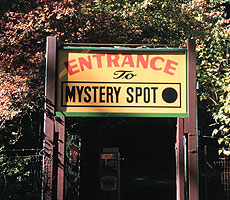October 3, 2005
Mystery Spot demonstrates power of perception, UCSC psychologist explains
Popular Santa Cruz tourist attraction isn't so mysterious, after all
By Jennifer McNulty
For years, UCSC psychology professor Bruce Bridgeman has taken college students to the Mystery Spot, a popular local tourist attraction, to demonstrate how the human brain works.

Mystery Spot managers welcomed his research on the attraction, said Bruce Bridgeman, below. |
 |
Tourists flock to the Mystery Spot to enjoy the "puzzling variations in gravity, perspective, height and more," leaving baffled and perplexed by the apparent exceptions to the laws of physics and gravity.
But for Bridgeman, the site is a powerful--and entertaining--way to demonstrate the influence of the visual context on perception. "It shows that you can teach serious science in unexpected places," said Bridgeman, who has published a scholarly article that explains the perceptual effects at work at the Mystery Spot. His article, "Influence of Visually Induced Expectation on Perceived Motor Effort: A Visual-Proprioceptive Interaction at the Santa Cruz Mystery Spot," appears in the June issue of Psychonomic Bulletin and Review.
Mystery Spot visitors will recognize the scene of Bridgeman's research: In a cabin on a steep hillside, an 8 kilogram weight hangs on a chain from the ceiling. Although the weight hangs vertically, the tilt of the cabin makes the weight appear to be suspended at an angle. Visitors find that pushing the weight one way is perceived as much more difficult than pushing it the other way. Rather than a magical defiance of gravity, the explanation lies in the "mismatch" between expectations and the actual weight: Expectations based on visual information override the proprioceptive experience of moving the weight. (Often referred to as the sixth sense, proprioception is an unconscious aspect of the sensory system that provides information essential to movement.)
Far from spoiling the fun, Bridgeman said understanding the phenomenon adds to the enjoyment of a visit to the Mystery Spot. "To me, it's much more fun to have something that's real than not," said Bridgeman. "The real fun is that you can learn about how your mind works in an interesting setting." Mystery Spot managers welcomed the experiment, he added.
In the study, seven subjects pushed the pendulum away from vertical in both directions and were asked to judge the required effort on a one-to-10 scale, with one described as "effortless" and 10 "immovable." All participants experienced the "effort illusion": perceived effort in pushing toward visual vertical was significantly greater than perceived effort in pushing away from visual vertical.
"The tilt of the cabin makes it appear that the pendulum is suspended in an impossible position," said Bridgeman. "It is as though some additional force holds the weight in this unstable position. That's why the visual illusion is so compelling, and why the expected force applied is so dramatically different from the actual force needed to move the weight." Pushing the weight toward what appears to be vertical will always require more force than expected, and pushing it away will always require less.
"The visual context strongly influences what you perceive, and you can't escape it, even if you know better," said Bridgeman. "Expectations and assumptions are as important to perceived weight as the actual effort required to move objects."
And what does the professor hope students take away from their visit to the Mystery Spot?
"We think of our perceptions as being pretty much accurate, but they seldom are," said Bridgeman, noting that people are notoriously inaccurate when they attempt to estimate things like distance and the slope of a hill, too. "The philosophy of the brain is not to be totally accurate but to reduce the chance of error. Perception in the service of action is error reduction."
In other words, he said, "We're wrong, but we're right enough to get us there."
 Email this story
Email this story
 Printer-friendly version
Printer-friendly version
 Return to Front Page
Return to Front Page